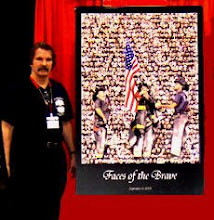Struggle at Ground Zero
Struggle at ground zero
The New York TimesSATURDAY, JULY 30, 2005
Somewhere in the ill-conceived campaign to "take back the memorial" at ground zero, false impressions have managed to triumph over facts. This week, Debra Burlingame, a board member of the World Trade Center Memorial Foundation, and others called for a boycott of fundraising for the memorial until the International Freedom Center and the Drawing Center have been banished from ground zero. She argues that money for the memorial will be intermingled with funds for the cultural building that is supposed to house the Freedom Center and the Drawing Center. This is both misleading and harmful to the memorial itself. The World Trade Center Memorial Foundation has pledged that its first priority is to build the memorial and create an endowment for it. Private donors are free to specify how they choose to have their money spent.
The attacks on the International Freedom Center - and, more broadly, on the cultural component of Daniel Libeskind's master plan - make it all too easy to forget the existence of a Memorial Museum devoted wholly to the events of 9/11. Opponents of the Freedom Center claim that the Memorial Museum will be dwarfed by the cultural center. In fact, they overstate the size of the Snohetta building, and they have exaggerated the floor space allotted there for the International Freedom Center. They also misleadingly make it sound as if the Memorial Museum, which at 50,000 square feet is larger than the public spaces in the Whitney Museum, is somehow a mere afterthought.
But this is not really a campaign about money or space. It is about political purity - about how people remember 9/11 and about how we choose to read its aftermath, including the Iraq war. On their Web site, www.takebackthememorial.org, critics of the cultural plan offer a resolution called Campaign America. It says that ground zero must contain no facilities "that house controversial debate, dialogue, artistic impressions, or exhibits referring to extraneous historical events."
This, to us, sounds un-American.
Somewhere in the ill-conceived campaign to "take back the memorial" at ground zero, false impressions have managed to triumph over facts. This week, Debra Burlingame, a board member of the World Trade Center Memorial Foundation, and others called for a boycott of fundraising for the memorial until the International Freedom Center and the Drawing Center have been banished from ground zero. She argues that money for the memorial will be intermingled with funds for the cultural building that is supposed to house the Freedom Center and the Drawing Center. This is both misleading and harmful to the memorial itself. The World Trade Center Memorial Foundation has pledged that its first priority is to build the memorial and create an endowment for it. Private donors are free to specify how they choose to have their money spent.
The attacks on the International Freedom Center - and, more broadly, on the cultural component of Daniel Libeskind's master plan - make it all too easy to forget the existence of a Memorial Museum devoted wholly to the events of 9/11. Opponents of the Freedom Center claim that the Memorial Museum will be dwarfed by the cultural center. In fact, they overstate the size of the Snohetta building, and they have exaggerated the floor space allotted there for the International Freedom Center. They also misleadingly make it sound as if the Memorial Museum, which at 50,000 square feet is larger than the public spaces in the Whitney Museum, is somehow a mere afterthought.
But this is not really a campaign about money or space. It is about political purity - about how people remember 9/11 and about how we choose to read its aftermath, including the Iraq war. On their Web site, www.takebackthememorial.org, critics of the cultural plan offer a resolution called Campaign America. It says that ground zero must contain no facilities "that house controversial debate, dialogue, artistic impressions, or exhibits referring to extraneous historical events."
This, to us, sounds un-American.


0 Comments:
Post a Comment
<< Home